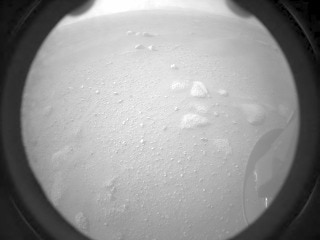NASA Perseverance Rover Photos: After Seven Months, NASA Mars Rover Perseverance Touches Red Planet
NASA Perseverance Rover Photos: The vehicle sailed through space for nearly 203 days covering 300 million miles before touching the Red planet and will be looking for signs of ancient Martian life.

The much awaited historic landing of the National Aeronautics and Space Administration (NASA) Mars rover Perseverance has been successful after it touched the Martian atmosphere and stationed safely inside a vast crater on Thursday. In its quest to the search for traces of ancient microbial life on the Mars, the most advanced astrobiology lab sent the Mars rover Perseverance. Also Read: Jammu And Kashmir: Encounter Underway Between Security Forces And Terrorists In Shopian And Budgam, 3 Militants Eliminated
In its official account, Nasa confirmed the landing saying it's just the beginning of the mission. "After 203 days and 300 million miles, NASA Mars rover Perseverance landed on Mars at 3:55 p.m. EST on Feb. 18. After spending some time checking out its systems, it'll be rolling across the Red Planet, looking for signs of ancient Martian life," it informed the world on its landing.

In fact, the NASA's Perseverance Mars Rover has a separate account on twitter updating about its status since the time it has been launched. After the landing, the page informed the whereabouts of the Rover saying, "It' is a great place. I have a new home now, but I’ll always remember my California roots."
It's a proud moment for India as the lead guidance and operations specialist Swati Mohan, who is an Indian origin, announced from the control room. “Perseverance safely on the surface of Mars.”
Meanwhile, US President Joe Biden also congratulated Nasa for the historic landing on micro blogging platform.
What's the mission?
Packed with groundbreaking technology, the Mars 2020 mission launched July 30, 2020, from Cape Canaveral Space Force Station in Florida. The Perseverance rover mission marks an ambitious first step in the effort to collect Mars samples and return them to Earth. A primary objective for Perseverance’s mission on Mars is astrobiology research, including the search for signs of ancient microbial life. The rover will characterize the planet’s geology and past climate and be the first mission to collect and cache Martian rock and regolith, paving the way for human exploration of the Red Planet.
It is to be noted here that Perseverance’s predecessor, the rover Curiosity, landed in 2012 and remains in operation, as does the stationary lander InSight, which arrived in 2018 to study the deep interior of Mars.
What's Perseverance going to observe?
About the size of a car, the 2,263-pound (1,026-kilogram) robotic geologist and astrobiologist will undergo several weeks of testing before it begins its two-year science investigation of Mars’ Jezero Crater. While the rover will investigate the rock and sediment of Jezero’s ancient lakebed and river delta to characterize the region’s geology and past climate, a fundamental part of its mission is astrobiology, including the search for signs of ancient microbial life. To that end, the Mars Sample Return campaign, being planned by NASA and ESA (European Space Agency), will allow scientists on Earth to study samples collected by Perseverance to search for definitive signs of past life using instruments too large and complex to send to the Red Planet.
“Because of today’s exciting events, the first pristine samples from carefully documented locations on another planet are another step closer to being returned to Earth,” said Thomas Zurbuchen, associate administrator for science at NASA. “Perseverance is the first step in bringing back rock and regolith from Mars. We don’t know what these pristine samples from Mars will tell us. But what they could tell us is monumental – including that life might have once existed beyond Earth.”






































